Adapted from http://www.mmdigest.com/Sounds/trompet.wav. The reed has a slight tendency to beat harder at every second period. This gives weak sub-harmonics emerging between the regular ones.

Evolving page, contributions are welcome.
Here are some pipe sound samples randomly collected from volunteering MMD subscribers. They are generally resampled into 11.025 kHz. In several cases it was also appropriate to edit, gain adjust, and/or 20 Hz highpass filter to remove a DC component from the signal. All samples are spectrum analyzed with a 100 ms Hamming time window (raised inverted cosine shape) giving effective analysis time 50 ms and bandwidth 20 Hz. The spectra are taken in the stationary part of the samples, in the interval from 0.1 to 0.2 s from start. Vertical scale is in dB with an arbitrary reference level. The absolute gains are unknown, so samples can not be mutually compared what concerns loudness or spectrum level. To limit file space the initial transient spectrum is not represented here, even though the difference between this and the stationary one may be highly characteristic to a pipe.
Geometrical and other data for the pipes are given when known. These are effective working measures: inside dimensions of a resonator, oscillating part of a reed, etc. When missing, contributors of sounds are encouraged to e-mail me such detail.
By clicking in the spectrum figures the corresponding sound .wav files are invoked. Further handling details depend on your local browser settings.
Trumpet. Hans van Oost.
Adapted from http://www.mmdigest.com/Sounds/trompet.wav. The reed has
a slight tendency to beat harder at every second period. This gives
weak
sub-harmonics emerging between the regular ones.

Experimental Bass. J Liljencrants.
Spruce, conical square, L=1470, W=70/14 mm. Brass reed 67*17*0.7 mm.
Pressure 2 kPa. jlsbf with leathered shallot, jlhbf with hardwood
shallot.
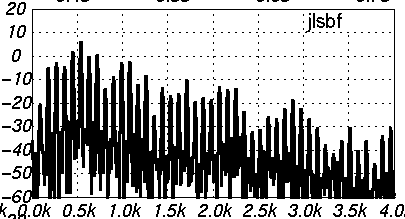
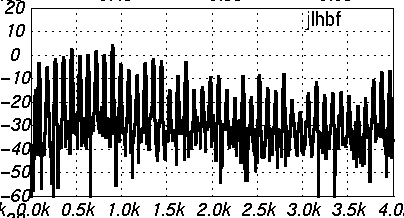
Experimental, aluminium reed 21*23*0.2 mm, bamboo shallot. Dave
Goggin.
(8 bit)
dgcof: cylindrical resonator, cardboard, L 170 mm, D 95 mm having
resonance
frequencies about 450*(1+2n) Hz, clearly visible in the spectrum
envelope.
dgcon: conical resonator, paper, L 570 mm, W 75/15 mm, fundamental
resonance estimated at about 250 Hz.
Mismatch between resonance and reed fundamental gives little coupling
between them and pitch is highly dependent on pressure.


dgstk: cylindrical resonator, bamboo, L 142, D 9 mm. Resonance
frequencies
about 1100*(1+2n) Hz with low Q. Spectrum probably represents reed
alone.

jlclc: cylindrical resonator, L 325, D 29 mm, brass tongue 30*8*0.3
mm, 2kPa.
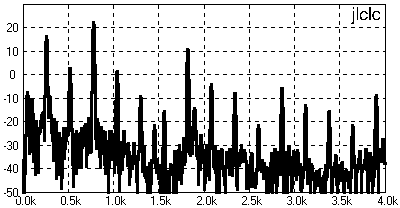
Gamba. Richard Weisenberger.
0.75" (19 mm) diameter, length (languid to top of pipe) of 12" (305
mm) and both a cutup as well as beard dimeter of .375" (10 mm). 20"
water
column (5 kPa). > 110 dB @ 1 meter
Open flute. Richard Weisenberger.
1" (25 mm) square, length 12" (305 mm), cutup 0.6" (15 mm). 20" water
column (5 kPa).> 110 dB @ 1 meter.
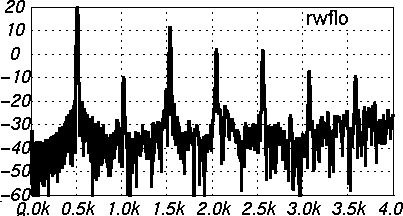
Tibia Plena. Richard Weisenberger.
2" (51 mm) square, length (languid to top of pipe) of 10" (254 mm)
and a cutup of .5" (13 mm). 20" water column (5 kPa).> 110 dB @ 1
meter

String pipe. Vicki Webb.
vwstr22 with high pressure, close to overblowing. vwstr12 with low
pressure.

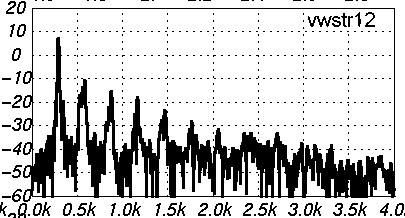
Built per http://www.mmdigest.com/Tech/pipesRecipe.html. J
Liljencrants.
Resonator 720*34 mm square. Mouth and flue 34*20*0.5 mm. Roll 34*10
mm. 2 kPa.

Resonator 340*22 mm square. Mouth and flue 22*11*0.5 mm. Roll 22*7
mm.
syno440 is synthetic replica using 6 pure sinusoids.


Resonator 157*15 mm. Mouth and flue 15*6.5*0.25 mm. Roll 34*10 mm.

5-ply cylindrical paper tube, resonator 157*29 mm dia, mouth and
flue
23*8.5*0.5 mm. J Liljencrants.

Built per http://www.mmdigest.com/Tech/flutes1.pdf by Vicky
Webb.
J Liljencrants.
Resonator 141*25 mm square. Mouth and flue 25*6*0.2 mm.

Adapted from http://www.mmdigest.com/Sounds/gedekt.wav. Hans van
Oost.

Stopped Flute. Richard Weisenberger.
Working length (languid to stopper) of 6", 1" square (152*25 mm) ,
cutup of 0.6" (15 mm). 20" water column (5 kPa). > 110 dB @ 1
meter.

Built per http://www.mmdigest.com/Tech/pipesRecipe.html. J
Liljencrants.
Resonator 166*22 mm. Mouth and flue 22*11*0.5 mm. Roll 22*7 mm. 2 kPa.
sync440 is synthetic replica using 5 pure sinusoids.
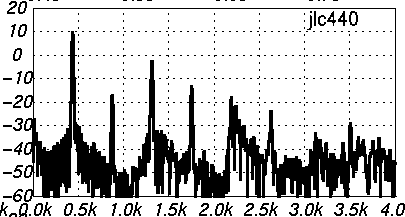

Resonator 77*12 mm. Mouth and flue 12*6*0.6 mm. Roll 34*10 mm.

Flute 335*25 mm square (13.2*1 in). dgfl1 cutup 12 mm. dgfl2 cutup 9
mm overblown. (8 bit). Dave Goggin.



Adapted from http://www.mmdigest.com/Sounds/viool.wav. Hans van
Oost.
Set of two pipes. Width of mouth: 16,5 mm and 15,5 mm, depth of pipes:
16,5 mm and 19 mm,. height of mouth: 6,5 mm (both), wind pressure: 180
mm WC, sounding length: abt. 344 mm (from upper lip to tuning slit).
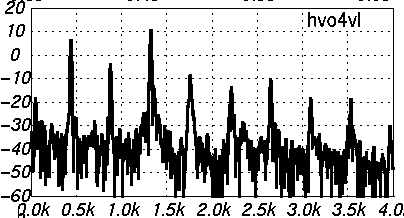
Built per http://www.mmdigest.com/Tech/pipesRecipe.html. J
Liljencrants.
Wedged resonator 210*21 mm, depth at flue 21 mm, at open end
40 mm. Mouth and flue 21*8*0.4 mm. 2 kPa.

-------------------------------------------------------------------------------------------------------
Updated 2000-06-01, 2009-02-25